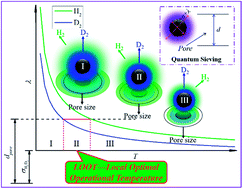Quantum sieving of H2/D2 in MOFs: a study on the correlation between the separation performance, pore size and temperature†
Abstract
Using an advanced cryogenic thermal desorption spectroscopy (ACTDS) apparatus together with the temperature-programmed desorption (TPD) methodology, three MOF materials with different textural characteristics were examined for the separation of an equimolar H2/D2 mixture through quantum sieving. Finally, a universal fundamental correlation between the separation performance of (equilibrium) quantum sieving and pore size with temperature is established, which, for specific pore apertures, results in a subordinate local optimal operational temperature (LOOT) phenomenon that is dominant at local temperatures; the influence of the textural characteristics of different materials on this correlation is also illustrated in detail and clearly demonstrates that a good material for efficient H2/D2 quantum sieving should possess homogeneous hydrophilic pores with only one strong adsorption site. These results will exert great directive significance on defining the optimal operational conditions and suitable materials for more effective H2/D2 quantum sieving performance in a practical way.



 Please wait while we load your content...
Please wait while we load your content...